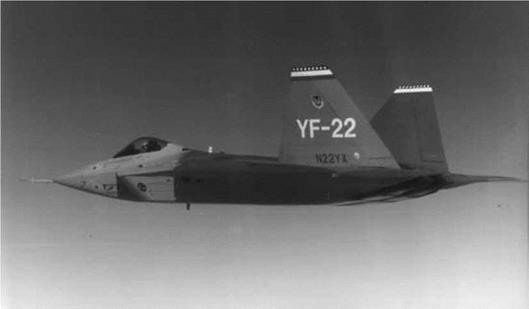Shielded Vertical Tails and Leading-Edge Flaps
Radar return from an airplane’s bottom is an important consideration if the airplane is to operate where hostile ground radars rather than air – or space-borne radars are the major defense. Intersections of vertical tails with wing or fuselage surfaces act as corner reflectors, increasing radar returns. This is the reason why vertical tails are located entirely above wing surfaces on airplanes such as the Lockheed F-117A and F-22 (Figure 22.3).
Vertical surface shielding from radar by above-wing mountings has the undesirable effect of shielding the vertical surfaces from the airflow at large positive angles of attack. Premature departures into uncontrolled flight and spins result. Canting vertical tail tips outward, as on the F-117A and F-22 designs, is intended to put at least the tail tips out in unshielded flow at large positive angles of attack.
The importance of radar returns from an airplane’s bottom was brought out by Fulghum (1994). He reported that some reduction in the number of underwing doors, access panels, and drain holes was required to lower radar returns from the F-22. Radar returns from seams or junctures between fixed and movable surfaces are another consideration. Leading – edge flaps in particular are a cause of concern because of the lower seam between the flap and wing. The F-22 is equipped with leading-edge flaps. The F-22’s leading-edge flaps
|
Figure 22.3 The Lockheed F-22, showing its vertical tail intersections with the wings that are shielded from ground radars. The vertical tail tips are canted outward to retain some effectiveness at high angles of attack. (From Lockheed Martin Corporation) |
|
Figure 22.4 NASA 8-Ft. Transonic Wind-Tunnel model ofaU. S. Air Force Multirole fighter concept, designed to have no vertical tail. Directional stability and control would be provided by thrust vectoring and low-radar-return control surfaces. (NASA photo 93-01934) |
are an important contributor to the airplane’s air combat capability, including its reported ability to fly stably at an angle of attack of 60 degrees. Leading- and trailing-edge flaps are programmed with Mach number and angle of attack to maintain lateral and directional stability.













